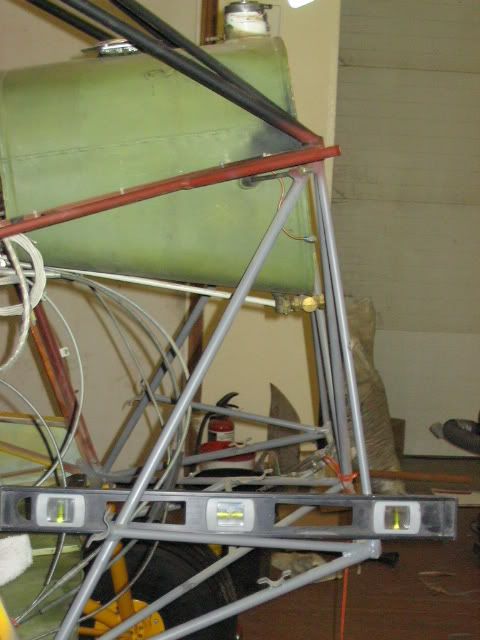BTW, I have identified the cause of most of my engine failure on takeoff events, thanks to another event today.
The bottom of the T-craft tank is slanted SLIGHTLY downward, so the fuel gravity feeds to the front, where the outlet is.
One day a few months ago, taxiing uphill to the departure end of the runway with very little fuel on board, the engine quit. I put more gas in, and flew home with no problems.
A few days after returning from a trip 3 weeks ago, I had a few gallons of car gas left in the airplane, and went out to fly and burn it off. I must have taxied onto the runway, turned the airplane onto the runway heading, and accelerated all in one fast move, the engine quit on takeoff. But I managed to keep it running, taxied off the runway, did three or four runups with no problem, and then took off again with no problems. I blamed it on the car gas, thinking something in the gas had swelled up the rubber tip carb needle.
Last week I installed 8.00 x 6 tires to get a higher deck angle on the ground (looks cool too!). I did not think about the fact that it made the slope of the bottom of the tank LESS steep relative to the horizon. Today I took off with about 6 gallons on board, and swung out onto the runway, turned to line up with the runway, and took off in one smooth fast motion. Guess what?!? It stuttered and quit on takeoff again. We taxied off the runway, did three or four runups, found nothing wrong with it, and taxied back to take off again. No problems on takeoff the second time because I was careful to line it up on the runway before accelerating.
It therefore appears the T-craft is very sensitive to un-porting the fuel outlet at the bottom of the tank when you have less than 4 gallons on board with 6.00 size tires, and even with 6 gallons on board if using 8.00 size tires. So please be aware of this very real problem if you are operating with minimal fuel in the airplane. I'm sure you would never have this issue if you always took off with 8 or 10 gallons on board, but there is supposed to be NO un-usable fuel in a T-craft so it is reasonable to assume you can take off with 45 minutes or an hour's fuel on board and not have a safety issue.
The only other "real" engine failure I had was one flight attempt with another carburetor altogether, which was genuinely malfunctioning and has been replaced.
The bottom of the T-craft tank is slanted SLIGHTLY downward, so the fuel gravity feeds to the front, where the outlet is.
One day a few months ago, taxiing uphill to the departure end of the runway with very little fuel on board, the engine quit. I put more gas in, and flew home with no problems.
A few days after returning from a trip 3 weeks ago, I had a few gallons of car gas left in the airplane, and went out to fly and burn it off. I must have taxied onto the runway, turned the airplane onto the runway heading, and accelerated all in one fast move, the engine quit on takeoff. But I managed to keep it running, taxied off the runway, did three or four runups with no problem, and then took off again with no problems. I blamed it on the car gas, thinking something in the gas had swelled up the rubber tip carb needle.
Last week I installed 8.00 x 6 tires to get a higher deck angle on the ground (looks cool too!). I did not think about the fact that it made the slope of the bottom of the tank LESS steep relative to the horizon. Today I took off with about 6 gallons on board, and swung out onto the runway, turned to line up with the runway, and took off in one smooth fast motion. Guess what?!? It stuttered and quit on takeoff again. We taxied off the runway, did three or four runups, found nothing wrong with it, and taxied back to take off again. No problems on takeoff the second time because I was careful to line it up on the runway before accelerating.
It therefore appears the T-craft is very sensitive to un-porting the fuel outlet at the bottom of the tank when you have less than 4 gallons on board with 6.00 size tires, and even with 6 gallons on board if using 8.00 size tires. So please be aware of this very real problem if you are operating with minimal fuel in the airplane. I'm sure you would never have this issue if you always took off with 8 or 10 gallons on board, but there is supposed to be NO un-usable fuel in a T-craft so it is reasonable to assume you can take off with 45 minutes or an hour's fuel on board and not have a safety issue.
The only other "real" engine failure I had was one flight attempt with another carburetor altogether, which was genuinely malfunctioning and has been replaced.






Comment